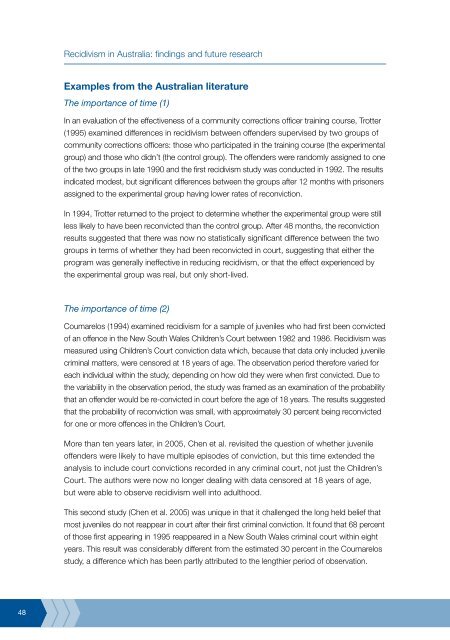Recidivism in Australia : findings and future research - Australian ...
Recidivism in Australia : findings and future research - Australian ...
Recidivism in Australia : findings and future research - Australian ...
You also want an ePaper? Increase the reach of your titles
YUMPU automatically turns print PDFs into web optimized ePapers that Google loves.
48<br />
<strong>Recidivism</strong> <strong>in</strong> <strong>Australia</strong>: f<strong>in</strong>d<strong>in</strong>gs <strong>and</strong> <strong>future</strong> <strong>research</strong><br />
Examples from the <strong>Australia</strong>n literature<br />
The importance of time (1)<br />
In an evaluation of the effectiveness of a community corrections officer tra<strong>in</strong><strong>in</strong>g course, Trotter<br />
(1995) exam<strong>in</strong>ed differences <strong>in</strong> recidivism between offenders supervised by two groups of<br />
community corrections officers: those who participated <strong>in</strong> the tra<strong>in</strong><strong>in</strong>g course (the experimental<br />
group) <strong>and</strong> those who didn’t (the control group). The offenders were r<strong>and</strong>omly assigned to one<br />
of the two groups <strong>in</strong> late 1990 <strong>and</strong> the first recidivism study was conducted <strong>in</strong> 1992. The results<br />
<strong>in</strong>dicated modest, but significant differences between the groups after 12 months with prisoners<br />
assigned to the experimental group hav<strong>in</strong>g lower rates of reconviction.<br />
In 1994, Trotter returned to the project to determ<strong>in</strong>e whether the experimental group were still<br />
less likely to have been reconvicted than the control group. After 48 months, the reconviction<br />
results suggested that there was now no statistically significant difference between the two<br />
groups <strong>in</strong> terms of whether they had been reconvicted <strong>in</strong> court, suggest<strong>in</strong>g that either the<br />
program was generally <strong>in</strong>effective <strong>in</strong> reduc<strong>in</strong>g recidivism, or that the effect experienced by<br />
the experimental group was real, but only short-lived.<br />
The importance of time (2)<br />
Coumarelos (1994) exam<strong>in</strong>ed recidivism for a sample of juveniles who had first been convicted<br />
of an offence <strong>in</strong> the New South Wales Children’s Court between 1982 <strong>and</strong> 1986. <strong>Recidivism</strong> was<br />
measured us<strong>in</strong>g Children’s Court conviction data which, because that data only <strong>in</strong>cluded juvenile<br />
crim<strong>in</strong>al matters, were censored at 18 years of age. The observation period therefore varied for<br />
each <strong>in</strong>dividual with<strong>in</strong> the study, depend<strong>in</strong>g on how old they were when first convicted. Due to<br />
the variability <strong>in</strong> the observation period, the study was framed as an exam<strong>in</strong>ation of the probability<br />
that an offender would be re-convicted <strong>in</strong> court before the age of 18 years. The results suggested<br />
that the probability of reconviction was small, with approximately 30 percent be<strong>in</strong>g reconvicted<br />
for one or more offences <strong>in</strong> the Children’s Court.<br />
More than ten years later, <strong>in</strong> 2005, Chen et al. revisited the question of whether juvenile<br />
offenders were likely to have multiple episodes of conviction, but this time extended the<br />
analysis to <strong>in</strong>clude court convictions recorded <strong>in</strong> any crim<strong>in</strong>al court, not just the Children’s<br />
Court. The authors were now no longer deal<strong>in</strong>g with data censored at 18 years of age,<br />
but were able to observe recidivism well <strong>in</strong>to adulthood.<br />
This second study (Chen et al. 2005) was unique <strong>in</strong> that it challenged the long held belief that<br />
most juveniles do not reappear <strong>in</strong> court after their first crim<strong>in</strong>al conviction. It found that 68 percent<br />
of those first appear<strong>in</strong>g <strong>in</strong> 1995 reappeared <strong>in</strong> a New South Wales crim<strong>in</strong>al court with<strong>in</strong> eight<br />
years. This result was considerably different from the estimated 30 percent <strong>in</strong> the Coumarelos<br />
study, a difference which has been partly attributed to the lengthier period of observation.















